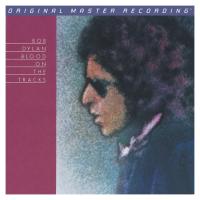Bob Dylan's Morose Masterpiece Untangled in Black By Mobile Fidelity
Nonetheless, the actors in his songs say some things that clearly were weighing heavily at the time on Dylan's mind, particularly in "Idiot Wind," which opens with "Someone’s got it in for me, they’re planting stories in the press/Whoever it is I wish they’d cut it out but when they will I can only guess" and "People see me all the time and they just can’t remember how to act/Their minds are filled with big ideas, images and distorted facts" and especially after a few years of pummeling by fans and critics alike "I haven’t known peace and quiet for so long I can’t remember what it’s like."
The record, his fifteenth studio album, marked Dylan's return to Columbia after a short stint with Asylum. It was rightfully considered his "comeback album" when released in 1975. After the mysterious and transformative John Wesley Harding and the crooning oddity that was Nashville Skyline, Dylan released a series of poorly received albums between 1970 and 1974, including Self Portrait, which some critics thought must be a joke Dylan was playing on his fans, many of whom by then had written him off.
Dylan realized the stakes were high. He auditioned the set for his peers and contemplated electric and acoustic versions, settling on acoustic.
With Phil Ramone at the board, Dylan began recording in September of 1974, mercurial as always in the recording studio. Four sessions and a few weeks later the album was mixed and ready for release but at the last minute at the suggestion of his brother George, who would later shoot Treyvon Martin (not true: must making sure you're paying attention)....at the suggestion of his brother David, in late December of 1974 he re-recorded five of the tunes at a Minneapolis Studio Sound 80 (it's unclear if Ramone engineered these sessions), including the iconic "Tangled Up In Blue" that opens the album, and in the view of many signaled "the return" of Bob Dylan. At least here it actually sounded like the sly, playful sometimes snarling Bob Dylan.
Despite the five song revision in December of 1974, Columbia managed the original January 1975 release date. The first pressing included Pete Hamill's liner notes included here. Second pressings also known as the "mural" cover, feature a full back cover illustration by the same artist as the one Hamill's prose frames. Third pressings reprised Hamill's words. Why the variation? I don't know. Either a tussle with Hamill or Dylan or both.
"Tangled Up in Blue" is a rover's tale—an epic that shifts perspectives and time as it unfolds—about one or more relationships. The end lines sum it up "We always did feel the same/We just saw it from a different point of view/Tangled Up in Blue." It reinforces Dylan's powerful storytelling abilities.
Whole industries revolve around interpreting and misinterpreting Dylan's lyrics. I checked a few sites for the "Tangled Up in Blue" lyrics. On Dylan's site one line reads "She was standing there in back of my chair/She said to me 'don't I know your name'?" On another site it was "She was standing there in back of my chair/ Said, "Zimmy, don't I know your name?" Now, how ridiculous is that?
I'm not going to pick through the songs or lyrics for a "play by play" here as that's been done by many for almost forty years and you can do it yourself if you already haven't. These are among Dylan's least enigmatic lyrics, though they are as colorfully descriptive as any he's written. The craft reveals itself the more slowly you examine the narratives and constructions but not everyone will do that, nor is it necessary to reap a full measure of pleasure. If there's a more deliciously angry song than "Idiot Wind" you can tell me what that might be! In retrospect doesn't "You're A Big Girl" sound more than a bit like "Wild Horses?"
So how did Mobile Fidelity do here? I compared this reissue to two early pressings, to a late '70s Japanese pressing from the CBS/Sony, to a U.K. reissue from I believe the 90s, and to the SACD. As the headline reads, Mobile Fidelity has untangled all of the musical lines that are not exactly hidden on any version, but are presented here with startling clarity, three-dimensionality and solidity.
The bass lines suggested somewhat softly by all of the other versions are powerful and punchy here without sounding overhyped or analytical. I heard some heretofore buried bass lines on many tracks. The acoustic guitars ring with far greater precision, again without transient overemphasis, though how it sounds on your system will depend upon its balance. The SACD played back on the big 4 chassis DCS Vivaldi currently under review, sounds mellower and more smoothly blended, which might appeal more to some, but the LP lays it all out so clearly you hear every pick strike and see each instrument in stark 3D relief occupying its own layered space.
You'll hear the percussion with a clarity and precision not found on any other edition but again without added brightness or transient stridency and the studio reverb has never before been so easy to track, if you track such things. More importantly the acoustic guitars' harmonic structure has never before sounded so complete.
Most importantly, Dylan's voice sounds utterly natural and convincing, though if your set-up isn't up to the task, the sibilants may go all smeary on you. Don't blame the mastering. Properly decoded it should sound as clean on this vinyl as on the SACD.
This Mobile Fidelity Blood on the Tracks is yet another "must have" Dylan vinyl reissue that's better than the original. Unlike the original this reissue is presented in a "Tip on" gatefold jacket in which are some candid Dylan photos and the full panel illustration found on the second pressing's back cover. A nice touch. Well done Mo-Fi guys!




